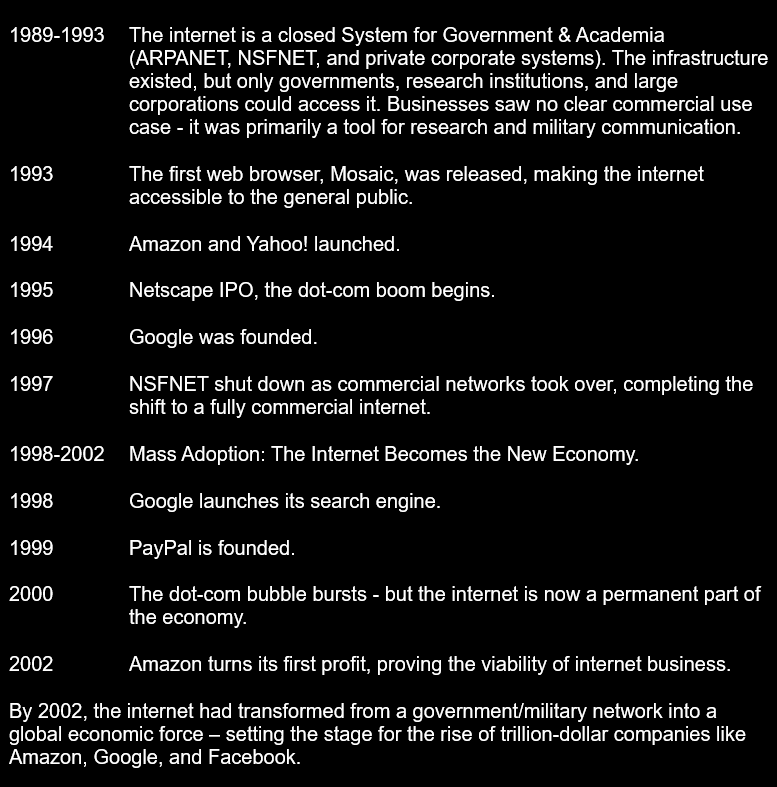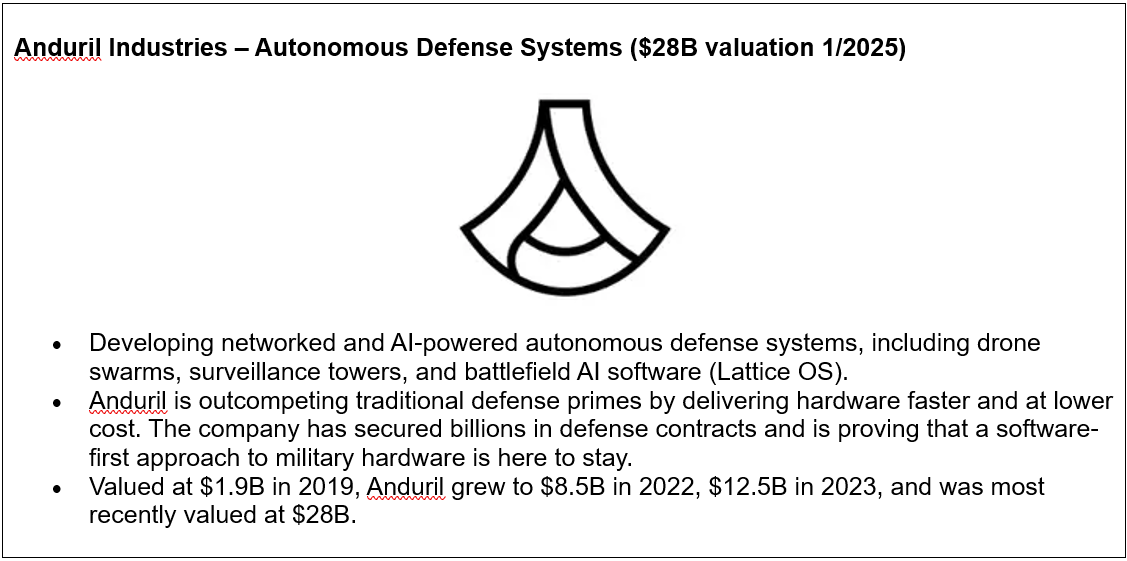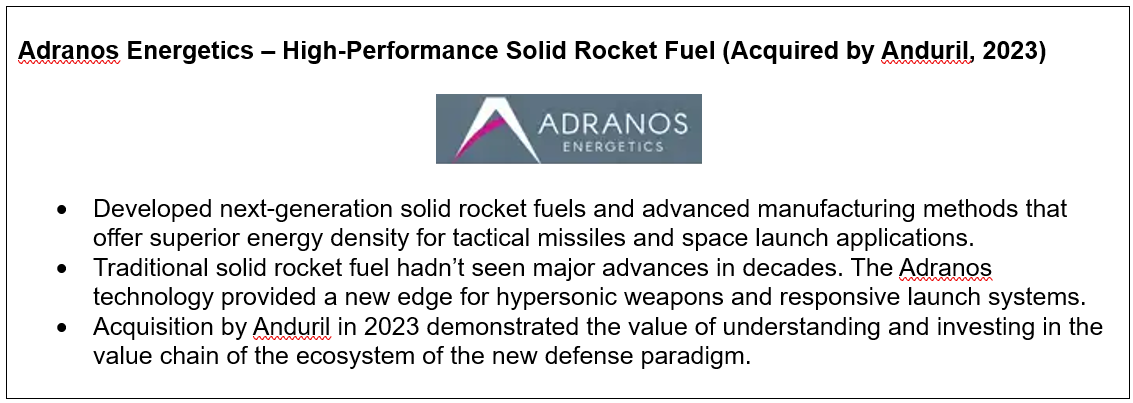We are at the cusp of an industrial explosion. The internet’s thirteen-year transformation from government networks to trillion-dollar giants 1989 to 2002 offers a model of what is happening in space and defense technology 2020 to 2033. Mass access to space driven by Starship, autonomous military technology, advanced manufacturing, and nuclear power are part of the new investment universe, defining the shift from software to hardware where new trillion-dollar market caps will be created. At Balerion Space Ventures, we are focused on the companies that will define this shift.
The Internet’s 13-Year Transformation 1989-2002: A Foreshadowing of the New Space Economy
In 1989, the internet as we know it didn’t exist. It was a closed system - controlled by the government, research institutions, and large corporations - used primarily for military communications and academic research. There were no consumer applications, no mass adoption, and certainly no trillion-dollar internet giants. Thirteen years later, the internet had become the foundation of a new economy. Companies like Amazon, Google, PayPal, and Netflix were to become dominant players defining the Big Tech era. This transformation wasn’t obvious at the start. In the early 1990s, even tech insiders couldn’t have predicted that companies run out of garages would one day dwarf the market caps of industrial giants like GE, Exxon, and IBM. The key inflection point came when access and infrastructure expanded, allowing mass participation, investment, and innovation. Today, we are standing at the same kind of moment for space and defense.
The 13-Year Transformation of Space 2020-2033: Mass Access to Space Leads to New Trillion-Dollar Companies
In 1989, the internet was a restricted and expensive tool limited to government, military, and large corporate use – similar to space prior to 2020. By 2002, mass internet adoption, along with complete commercialization of the system, had unlocked new industries, trillion-dollar companies, and an economic realignment no one had predicted. Now, space is undergoing the same transformation driven by radical cost reductions in access.
· The drop in the cost of launch from $50,000/kg to under $100/kg echoes the transition from pre-internet mainframes to mass mobile broadband.
· Mass access to space is now inevitable. New, previously inconceivable, business models will flourish.
· As the internet enabled trillion-dollar companies we didn’t predict, the new space economy will create trillion-dollar industries that don’t yet exist.
· An entirely new economic framework, focused on hardware and real goods this time, emerges.
Old model (pre-Starship, pre-2020s):
· Custom-built satellites costing hundreds of millions.
· One-shot, high-risk missions, requiring years of planning.
· Government-driven demand, with few private players.
New model (post-Starship, 2020-2033):
· Mass-manufactured, software-defined satellites, built at scale.
· Frequent, iterative launches, allowing real-time innovation.
· Private-sector leadership, creating commercial demand for space-based industries.
In 1995, it was hard to know that Amazon would evolve from an online bookstore into a cloud computing empire, Netflix would start as a DVD rental service and become a streaming giant, and PayPal would emerge from a failed cryptography startup and dominate global payments. Similarly, in 2025, we don’t know what the Amazons and Googles enabled by space will be, but we know the categories from where they will emerge:
· Satellite & Direct-to-Device Connectivity - Global broadband, Internet of Things (IoT), military applications.
· Microgravity Manufacturing - Space-based drug formulation, biologic development, semiconductor production.
· Lunar & Asteroid Resource Extraction - In-situ fuel production, rare minerals, industrial expansion.
· In-Space Infrastructure - Assembly of habitats, refueling stations, modular factories.
· High-Frequency Space Tourism - Will scale as access grows.
· Mars Industrialization & Human Settlement - The first sustained human presence on Mars, enabled by regular Starship flights, in-situ resource utilization (ISRU) for fuel, water, and building materials, and robotic infrastructure development before human arrival.
The coming trillion-dollar space companies are being born.
The Mass Model of Defense: Autonomy and Scale Reshape Warfare
The transformation in modern defense is as comprehensive as the one outlined for space. Military might has been defined by large and technological marvels like fighter jets, missiles, aircraft carriers, submarines, stealth bombers, and battle tanks. Governments invested in a small number of highly sophisticated and expensive assets. Today, warfare is rapidly shifting to the “mass” model where dominance is achieved through a large number of inexpensive (but capable) assets. Large-scale manufacture of an overwhelming number of flexible and autonomous units is what determines security and victory. As the internet and space industries are undergoing a shift toward mass accessibility, so too is defense.
The war in Ukraine has been a demonstration of the emerging role of mass-produced, low-cost drones in redefining modern combat. Instead of relying solely on tanks and artillery, Ukraine has deployed thousands of FPV (first-person view) kamikaze drones, costing just a few hundred dollars each. These drones have destroyed multi-million-dollar Russian tanks, vehicles, and artillery pieces, showing that cheap, mass-produced systems can neutralize expensive legacy platforms. Off-the-shelf DJI Mavic drones, intended for civilian photography, have been repurposed for battlefield reconnaissance, artillery targeting, and even dropping grenades. A drone that costs $2,000-$5,000 can neutralize enemy positions and disrupt operations at a fraction of the cost of traditional weapons.
Likewise, in the Middle East drone and missile swarms have challenged costly legacy hardware. For example, the Houthis (a non-state actor with limited funding) have launched waves of low-cost drones and missiles against Saudi oil facilities and military targets forcing Saudi Arabia to respond with multi-million-dollar Patriot missiles at $3 to $5 million per shot to intercept drones that cost just a few thousand dollars. This is economically unsustainable; it shows why defense must shift toward cheap, scalable countermeasures instead of relying on a limited number of expensive systems.
Old Model (modern 20th century military to early 2020s):
· A few, highly expensive, highly specialized assets (e.g., F-35, aircraft carriers, tactical missiles).
· Built for deterrence and long-term engagements rather than rapid adaptation.
· Procurement cycles measured in decades, not months. Government pays for long development cycles via cost plus contracting.
New Model (Mass, 2020-2033):
· Thousands of smaller, cheaper, autonomous assets (drones, robotic combat vehicles, AI-driven defense platforms).
· Speed and scale matter more than per-unit capability.
· Procurement is iterative and fast, driven by software, AI, and mass production.
· Government purchases already-completed products. Research and development paid for with private investment capital.
Like SpaceX in space, Anduril Industries exemplifies the new era in defense with AI-driven defense systems that scale like software, not like traditional defense programs.
· Autonomous drone swarms – Rather than a handful of expensive jets, the US and allies are shifting toward thousands of AI-driven, networked drone systems.
· Cheap, disposable, and rapidly replenishable – Unlike F-35s, for example, autonomous combat drones can be produced cheaply and at scale. The competitive advantage in battle is shifted more toward manufacturing capability and depth as much as actual hardware advantage.
· Iterative software-defined warfare – Mass-produced hardware systems are connected and integrated, and they can update and evolve continuously.
Echoing how Amazon and Google outcompeted traditional industries, the new defense model embraces scalability, automation, and AI-driven optimization rather than relying on a small number of high-cost products. The companies like Anduril that are leading this revolution will define 21st-century warfare.
Investing in the Builders of the New Industrial Era
Historically, major industrial and technological shifts created trillion-dollar winners. In the 1990s internet boom it was companies like Amazon, Google, and PayPal. The vision of a new space and defense technology landscape is already happening now, and leading to incredible investment opportunities. In the 2020s, so far, SpaceX and Anduril are two out of many outsized returns over the past couple of years. Balerion Space Ventures invests in companies throughout these emerging value chains in space and defense helping to build the next great industrial era.

Where the next trillion-dollar companies will emerge:
· Space Infrastructure & Connectivity – Satellite networks, direct-to-cell broadband, interplanetary logistics.
· Nuclear Power & Propulsion – Fuel (LEU and HALEU), space and portable reactors, fusion propulsion.
· Autonomous Defense & AI Warfare – Drone swarms, AI-driven combat networks, hypersonic deterrence.
· Advanced Manufacturing – High-rate, automated production of defense and space assets.
· In-Space Industry – Microgravity drug manufacturing, resource extraction, orbital assembly.
The companies that execute in these categories will define the global, and off-globe, industrial landscape for decades to come.
What separates winning companies in the new models of space and defense technology?
· Agility Over Bureaucracy - Small, fast-moving startups will outcompete traditional defense primes.
· Private Capital First - The biggest winners will be companies that can scale without waiting for government funding.
· Manufacturing Depth - Competitive advantage will be less about innovation alone and more about the ability to mass-produce.
· Rapid iteration development models – Build, test, revise.
· Critical long-term components of the emerging ecosystem.
New Era Company Profiles
The space and defense technology markets are already delivering massive returns. Valuations are rising quickly as private capital flows into industrial hardware sectors. The biggest returns will come from companies that scale fast and master production. This is the new industrial revolution - the new space and defense industrial complex - and the time to invest is now.
Building For the World and Extending Humanity’s Reach for the Stars: The New Industrial Era is Here
The transformation of space, defense, and advanced manufacturing is no longer a theoretical shift; it is happening now. The force of mass access to the internet that created trillion-dollar tech giants in the 1990s and 2000s is being echoed by mass access to space and advanced manufacturing that are now reshaping the physical industries that power the world, and the emerging world off earth.
Launch costs are rapidly decreasing and will soon make space accessible at mass scale. Defense is shifting from high-cost assets to AI-driven, mass-produced systems. Industrial production is moving from traditional slow development cycles to rapid iteration. This is the next great technological boom, one that will create new trillion-dollar companies, redefine global power structures, and open entire new industries in space and defense. Balerion Space Ventures is investing at the forefront of this new industrial era. We support the founders, technologies, and manufacturing capabilities that will build the future. The companies and industries outlined here are just the beginning. The next decade will bring the rise of hardware-first, deep-tech startups that will dwarf today’s dominant players. It’s time to build!



















